
Alan Powers moved into this flat-fronted terraced house of London stock brick 35 years ago. He was a youthful painter manque who has instead become a historian of twentieth century art and architecture, the author of a prodigious number of books with a very thorough, sympathetic understanding of the work that he writes about.

Alan and his wife Susanna Curtis soon after they moved into their London house. This is the room shown in the previous photograph, this was the only intact chimneypiece and grate left in the house, although the marble was painted brown.
‘I was aware there were a number of houses up for sale all at once around here. I was standing on the other side of the street one morning and someone in the doorway came over and said, do you want to look around? So I did. Part of my imagining of it was that, because there was a shop on the ground floor, that’d be rather fun. We exchanged contracts on April Fool’s day in 1983. It was uninhabitable, that’s why it was cheap.’
The elegant fender behind them came from a compost heap in Trengwainton in Cornwall. ‘I had a brief to do a picture of all the National Trust properties in Devon and Cornwall. I was doing pictures of Gunnera or something. When we drove in my eye was caught by that pattern of mesh against grass clippings. Susanna went and rang the doorbell and they didn’t want it.’

‘I made the transition, if you like, from being a aspirant artist to a grown up,’ he says. ‘My father was an amateur painter and he had a copy of Barbara Jones’s book, Watercolour Painting (1960). I read it and really enjoyed it, and used it as my guide and followed her instructions: get proper paints, don’t use too many colours, work on big sheets of paper, basically get on with it, avoid clichés.’

Hanging next to the chimneypiece is this painting by Barbara Jones, the study for a much larger work recently exhibited at the Fine Art Society. ‘What pink is that on the walls?’ ‘Well, we mixed it.’

His excellent, very beautiful book, Modern Block Printed Textiles, was published in 1992. It is seen here with a selection of samples of the papers designed by artists – Enid Marx, Eric Ravilious, Edward Bawden and others – for bookbinding or wrapping, which were formerly printed and sold from the Powers’s Judd Street Gallery. Alan Powers’s latest book is Enid Marx, The Pleasures of Pattern published to coincide with a show of her work at the House of Illustration in London N.1. Marx (1902-1998) was a textile designer, printmaker, author, designer and illustrator. The fabulous collection of Folk and Popular Art that she made with her friend Margaret Lambert is at Compton Verney Museum in Warwickshire.

Their kitchen. ‘My father was an architect and so interested in the graphics side of things he was a reluctant modernist.He studied at the AA in the 1930s, his friends all got inspired by Corbusier. His taste in art was quite conservative. We all had Ravilious alphabet mugs as children, I wish he had bought more. We had Coles wallpaper in the house at Hampstead and we had Ardizzone books read to us.’

The candles may conceivably be from Pentreath and Hall.

On the hooks, Persephone teacups by Ravilious for Wedgwood.

Beauty and utility

I wish I could remember the name of the designer who made these mugs [Alan Powers writes, It is Kate Irvine.]

‘My father went to a Great Bardfield open weekend and came back with a John Aldridge watercolour which I’ve got on the stairs here.’

The lobster pot painting is by Mildred Eldridge,RWS, (1909-1991) another ‘lost’ women artist and the first wife of the clergyman-poet R.S.Thomas. ‘I found her address and wrote to her and asked if I could go and see her but she rather fended me off. After she died her son Gwyddion bought this to the door, it was about £500, by way of a thank you, I think.’

‘We let the space in our gallery downstairs to artists who were friends of friends. the income was questionable. When we started publishing prints we had a mild success financially. We began with a Ravilious handkerchief and succeeded in printing it on cotton.’
Eric Ravilious: Artist and Designer, was published by Alan Powers in 2013. ‘With Ravilious, there was the pottery but it was very hard to see the watercolours anywhere. I knew them through books. Because I was painting watercolours I was very interested in what he said about his painting technique. Then in 1982 there was the ceramics exhibition put on by Richard Dennis and I bought one piece. The machine was cranking up. I remember saying, in ten years time the Great Bardfield artists will have replaced the Bloomsbury Group. When I said it, it sounded preposterous but now it isn’t. Ravilious has got a greater interiority than Bawden, I think. But we’re as interested in the gossip, now, as we are in the art.’

Take the Broom, Edward Bawden’s story for children reprinted and sold by Alan and Susanna Powers from the Judd Street Gallery.

‘Writing Ardizzone was very enjoyable. With all the books Ive done, I’ve been quite interested in the mechanics of the artists life, how much they earned and the conditions of production.’
‘Enid Marx and Miss Lambert kept house together and they had a creative relationship. Whether they were a couple, it’s hard to untangle that.’

Bedroom. ‘I remember there was a moment when we’d been here for a couple of years, and I thought, I don’t really care about interior decorations. Some people call this ‘Canary Lustre,’ I saw two pieces in a shop in Winchcombe,, I bought one piece and then went back and got the other. I’ve never seen it for sale before.I knew Dadie Rylands who had a big collection, he had a cupboard full.’
‘That print is a George Braque, bought for 20 francs in 1973 at the Foundation Maeght in Venice. The chimneypiece was also painted brown. The grate came from Charles Brooking. For a while we had an extra pair of paneled double doors out of a skip but they went off to Blackheath to the house of a man who worked in the local camera shop.’
‘We don’t really do bedrooms in this house very much.’

Design for a toy theatre play by Barbara Jones. ‘What do you do when you get another picture, does one get bumped out? ‘Well, we occasionally re-jiggle.’

Bathroom, ‘School print,’ Tractor, by Kenneth Rowntree over the chimney

‘I got very keen on Kenneth Rowntree. That we bought from the studio sale. It was a kind of first version of his curtain material for Edinburgh Weavers.’

Rowntree’s Alphabet, also one of the printed artists papers sold from Judd Street Gallery.

Bathroom curtains.

‘The chest of drawers, I think it came from the copper workshops at Newlyn but I can’t be sure. It all came from my grandfather’s family, they were Liverpool Unitarians. My great grandmother was rather artistic.’

Little Wedgwood ‘Clovelly’ porcelain mug by Rex Whistler. Just seen on the shelf in the previous photograph.

An early work by Alan Powers. ‘I got into murals because we had all the books about Rex Whistler at home. I tried to imitate him, I didn’t really have the skill but it was an education. I thought id like to paint trompe l’oeil rooms. A friend of mine, Christopher Scott, said, We’re all going to build a folly this holiday. His family had a house below Blackwell. It was a sort of joke but done in earnest, we were quite adept at building with concrete blocks because we wanted to avoid games at school and we’d done something called Pioneering. It was classical, an octagonal style temple with a dome, a cupola, and I painted some mural which must have been the first I’d done.’

Library cum sitting room.

Mantlepiece in the library. In the middle is the Giraffe House at London Zoo by Caroline Bullock (aka Carrie Boyd Harte).

‘The sailors jugs, I’d never seen one like the middle one before. My old commissioning editor for Ravilious sent an Xmas card, a photo of herself and her husband with a vintage car outside an antique shop. And that jug was in the window. I hadn’t realised how big it was until it came out of its box. My daughter Eleanor bought that Second World War prisoner of war picture above it.’

An enviable shelf of illustrated books. “I think I launched the book cover fetish thing with a book for Mitchell Beazley in about 2000, Front Cover: Great Book Jacket and Cover Design. Barnett Friedman is pretty much the top I think.’

‘I did topographical work and illustration for the school magazine. Then I got to Cambridge and carried on essentially doing more of the same. I organised the college art group at Clare, I put on an art show of Quentin Bell and that was when I first met Glynn [Boyd Harte], he was teaching illustration there and turned up for the opening dressed in white and making sardonic comments. He’d been taught by Quentin Blake, and he did that thing, ‘Oh! So ghastly!’ Five years later Gavin [Stamp] introduced me to him.’

‘This is something I did for Glynn, which Carrie [Boyd Harte] gave back to me, I was very touched. He gave me a crayon drawing so I thought I should do something for him. It’s sort of meant to be J.D. Papworth. It’s got Glynn’s archness and bits of his graphic style.’

Card painted by Alan Powers.
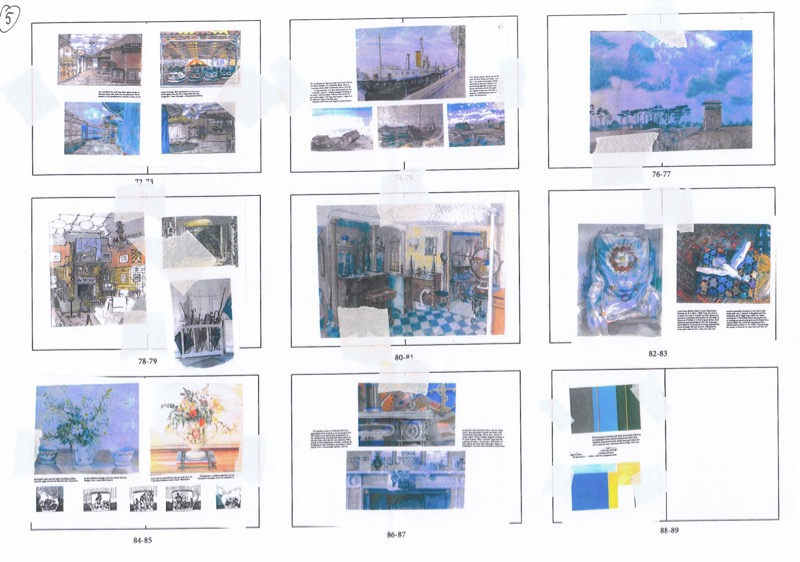
A set of early proof pages from Alan Power’s forthcoming book charting his life in art, letters and design so far, work in progress.

Enid Marx: Print, Pattern and Popular Art is at the House of Illustration at 2 Granary Square Kings Cross LONDON N1C 4BH until 23 September 2018. Next, the not entirely unrelated, but short, career of Suzanne Cooper.

Hanging here on the wall of an old Suffolk house with two of Eric Ravilious’s Wedgwood ‘Garden’ plates is Suzanne Cooper’s compellingly odd portrait of a girl with two kittens. Suzanne’s children have remarked that the sitter’s arched eyebrows and the double curve of her hairline are unmistakably those of their father Michael Franklin, whom Cooper married in 1940 aged 24 soon after leaving art college.
Suzanne Cooper (1916-1992) is a so-called ‘lost’ painter who has just been ‘rediscovered,’ an affliction particularly common among female artists working between the wars that is only just beginning to be remedied. Her children grew up in a house hung with her pictures but their mother barely mentioned her past career in art. One of them is the publisher Dan Franklin who is married to writer Lucy Hughes-Hallett. Three years ago Lucy spotted another of her late mother in law’s paintings hanging beside works by Christopher Wood and Alfred Wallis in the National Gallery of New Zealand and found that it had been donated by the art patron Lucy Carrington-Wertheim, in whose London gallery Suzanne Cooper used to show.
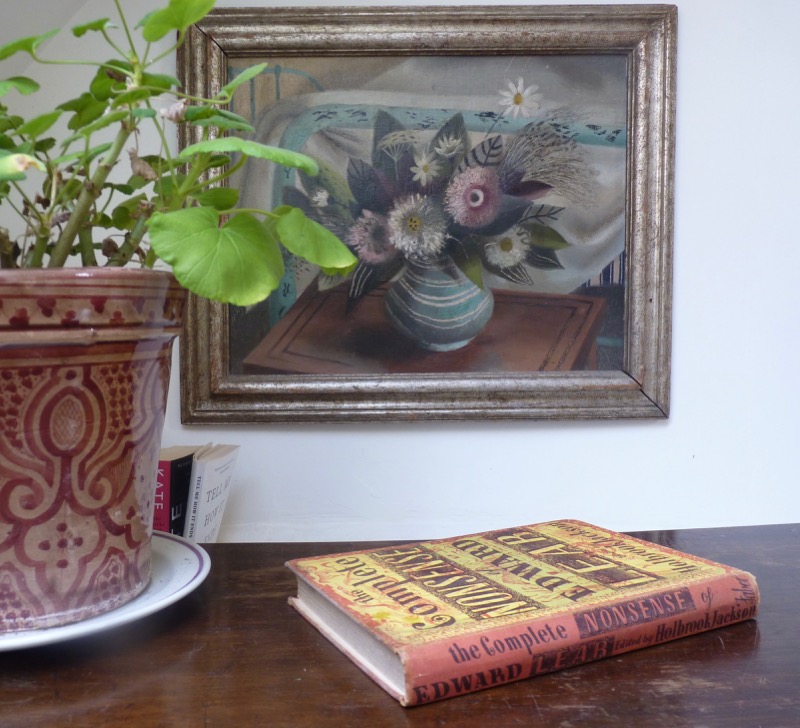
Upstairs in the bedroom of their Suffolk country house where I was staying one weekend recently, was this still life, The Blue Jug, dated 1945. Behind the flowers is a narrow iron bedstead painted a pale blue. ‘How does she make a vase of flowers look so creepy?’ someone had said to me when it was first shown at the Fry Art Gallery a few months earlier. The painting has a sick room, convalescent ward atmosphere and the bare quality of the almost empty bedrooms painted by Ravilious and Bawden at Brick House in the 1930s. The depiction of rust on the top of the bed rail is masterly. Some of Cooper’s paintings have a faintly Surrealist tinge, while her landscapes are redolent of those by Christopher Woods and Ravilious.

Above the bed in the main bedroom is Cooper’s Still Life composed of the souvenirs of a cruise she took in 1938.

She kept the seashells for the rest of her life. Inanimate objects are in dynamic movement; darts fly, paper flutters. John Piper would have been justly proud of this had he painted it in the 30s, although he would probably have added some Cubist-style elements of collage. My photographs don’t do them justice, but you can see much better reproductions of these pictures here: https://www.suzannecooper.org/oil-paintings/

Bedroom chest of drawers, the Venetian mirror belonged to Suzanne and her husband Michael Franklin and was passed down to their son Dan.

On the opposite bedroom wall a collection of little pictures includes two Edward Ardizzone sketches collected by Lucy’s late mother, Penelope Hughes-Hallett who was also a writer.

Christmas card by Ardizzone

In a dark corner behind my bedroom door…

Suzanne Cooper’s Yellow Horse (detail). Cooper went to the Grosvenor School of Modern Art in London at the age of 19, and then exhibited her oil-paintings and wood-engravings at the Redfern Gallery, the Zwemmer Gallery, with the National Society of Painters, Sculptors and Print-Makers and the Society of Women Artists.

Cooper’s choppy, Thames in October (detail) , oil on canvas, dated 1936, exhibited at the Royal Institute Galleries with the National Society.

Renwick Coals. Lucy had very sweetly hung and propped no less than four of Suzanne Cooper paintings in the bedroom in which I stayed for the weekend, this one is mounted on a chair as temporary easel.

Downstairs sitting room in the oldest part of the house.

The early 17th century core of the house was probably built for other more utilitarian purposes.

The previous owners thought it was a smoke-house (hence the massive chimney).

Lucy’s mother found this enormous framed lithograph by David Gentleman, Cornish Pilchard Boat ( published by J Lyons and Co) hanging disregarded in a village hall and bought it on the spot

Street Scene by Suzanne Cooper on the upstairs landing

Biographer and novelist Lucy Hughes-Hallett. Her latest book is Peculiar Ground, a novel set in a seventeenth century English country house. The vivid rug comes from Tipasa, the ruined Roman city along the coast from Algiers. She bought it when she was there last winter with a writers delegation.

These cushions were made up from old ethnic shawls and scarves collected by Lucy’s late mother. The little landscape in oils, bottom right, is Suzanne Cooper’s Pink House, exhibited with the National Society of Painters, Sculptors and Wood Engravers 1947; the beach-scape above it is by Lucy’s father, Michael Hughes-Hallett.

Just seen above the window seat is Appledore, signed and dated 1938, which was shown with The National Society of Painters, Sculptors and Wood Engravers at the Royal Institute Galleries, Piccadilly. Suzanne Cooper probably visited this small and very picturesque Devon fishing village while staying with her grandparents at Torquay.
Staffordshire dogs are family pieces that belonged to Suzanne Cooper and her husband, now they are her son Dan’s. The armorial plates come from Lucy’s family.

Their huge and loving hound Kilburn was chosen and named by their daughter Mary Franklin, a theatre director. Her company is named Rough Haired Pointer in his honour.

He has a very merry temperament

and often barks for joy.

Lucian Freud’s oddly similar portrait of his lover Kitty Garman, Girl with Kitten, was painted in 1947. The chair belonged to Dan Franklin’s parents. He remembers it from his childhood but doesn’t know where it came from. It was one of the few things they kept as they moved into smaller and smaller houses. The old wooden brewers malt shovel, on the other hand, was his impulse buy in a local junk shop.

Cooper had three children, and after her marriage in 1940 she produced no more large scale oil paintings.But dozens more of her playful, evocative pictures that were sold to private buyers during the 30s are waiting to be re-identified.
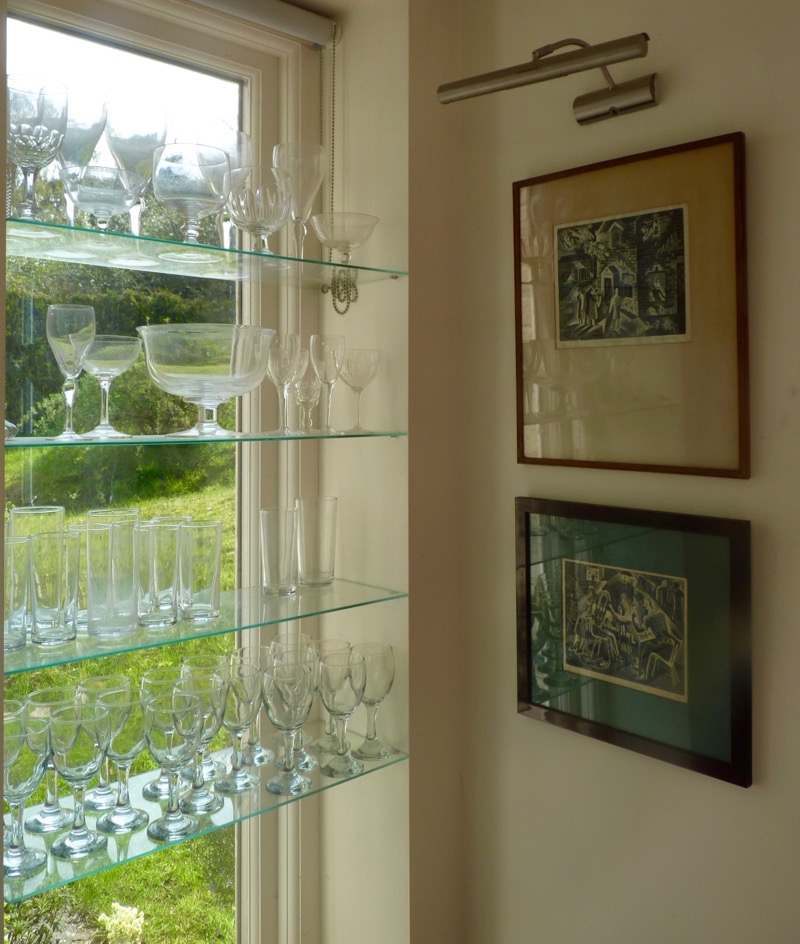
Very many thanks to Alan and Susanna Powers, Dan Franklin and Lucy Hughes-Hallett.
All photographs copyright bibleofbritishtaste.
Excerpts and links may be used, provided that full and clear credit is given to bibleofbritishtaste, with appropriate and specific direction to the original content.

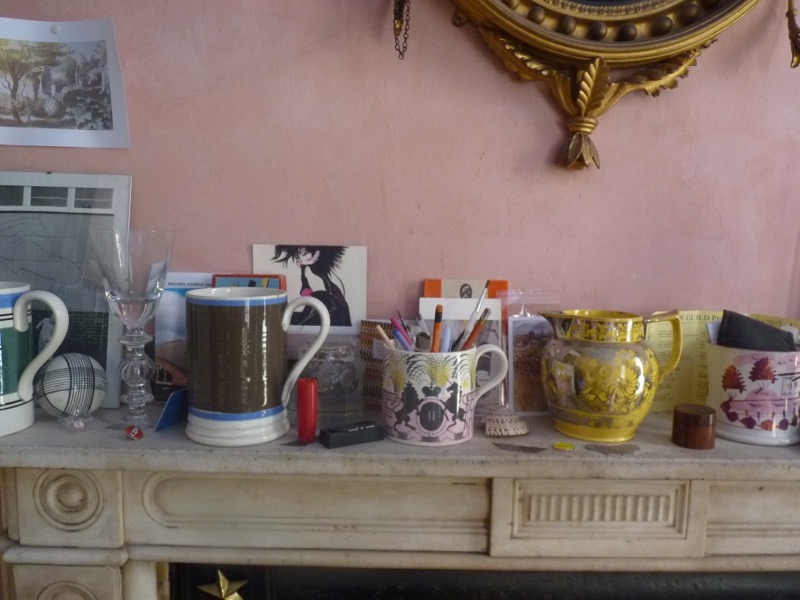
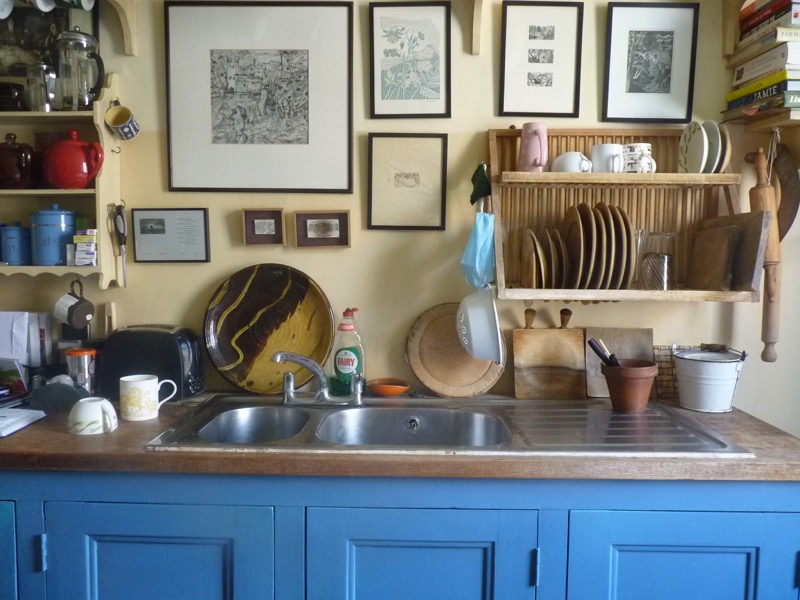
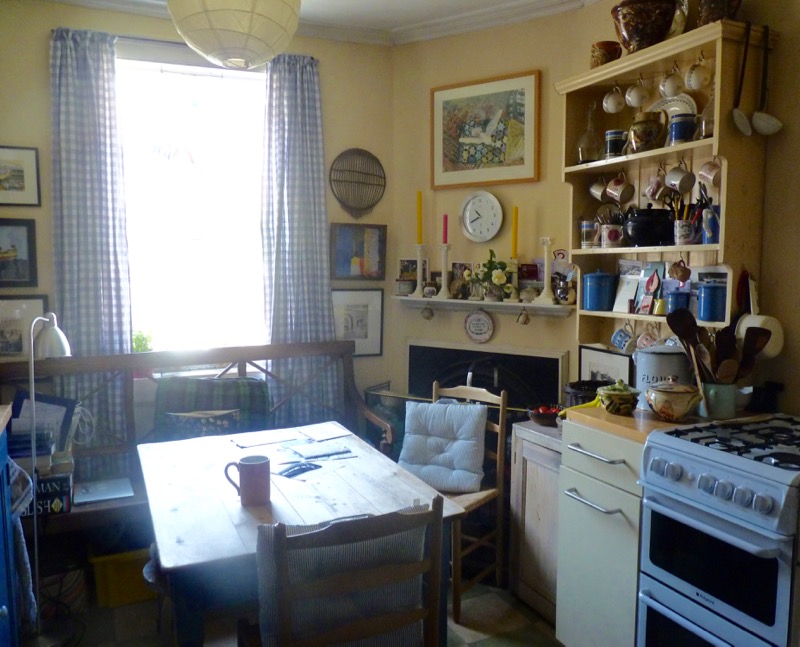
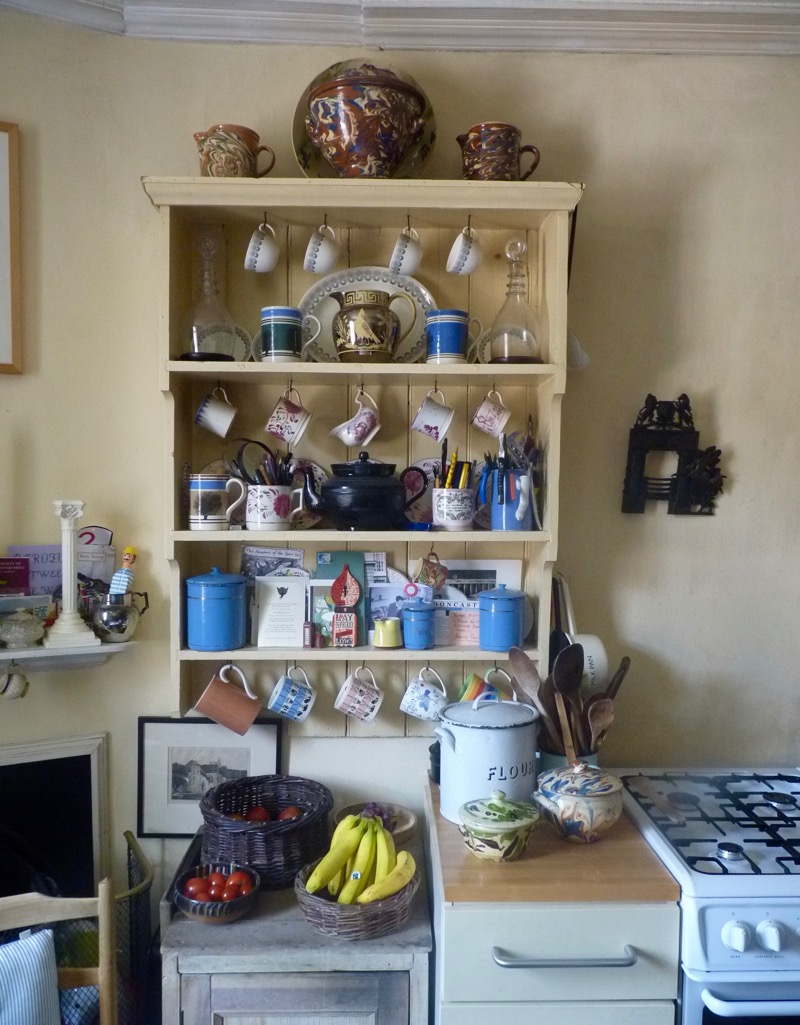
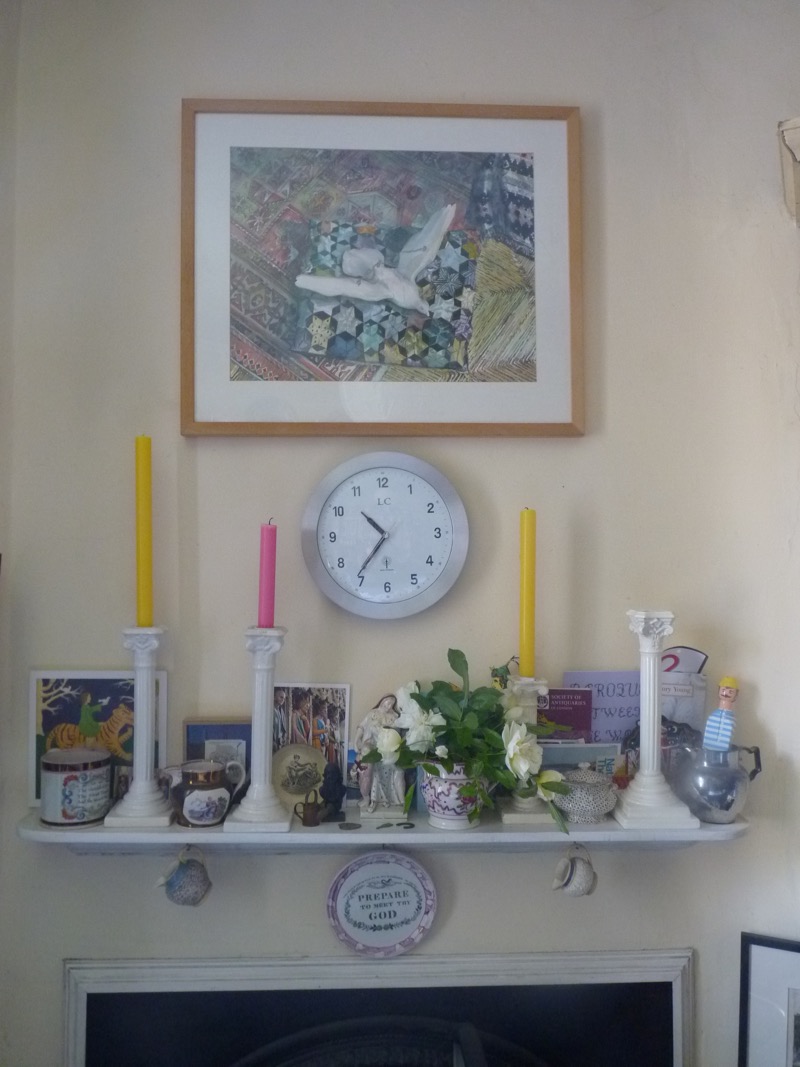
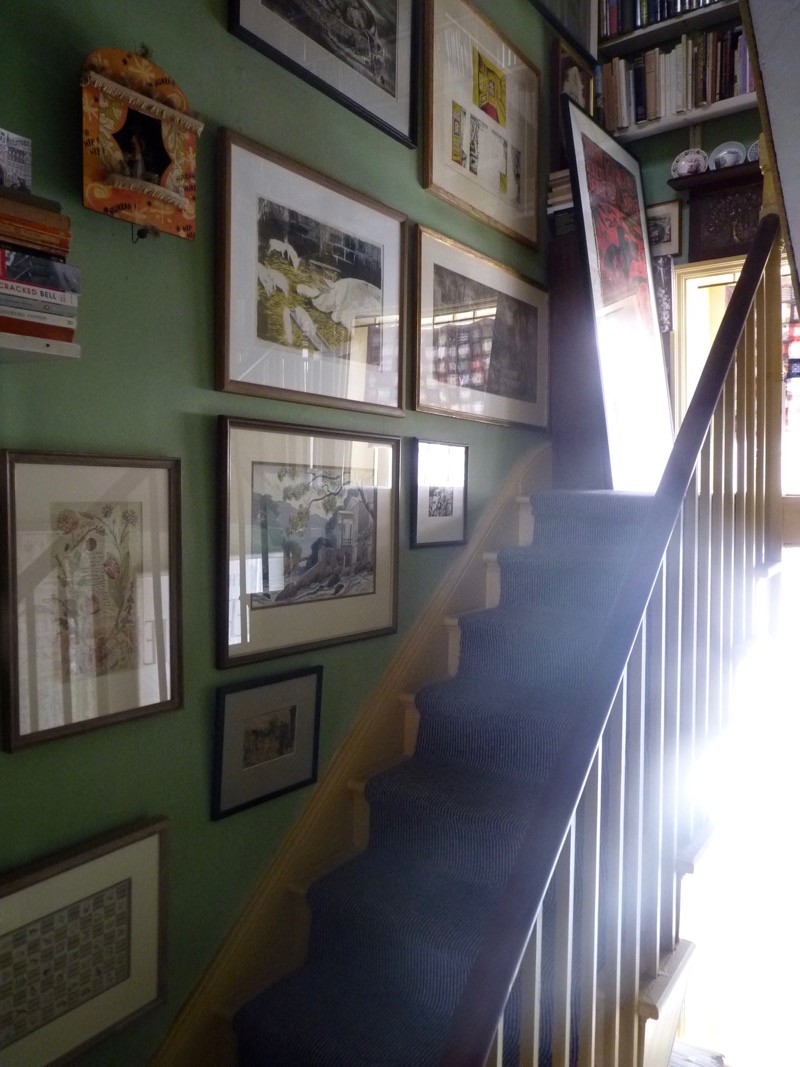
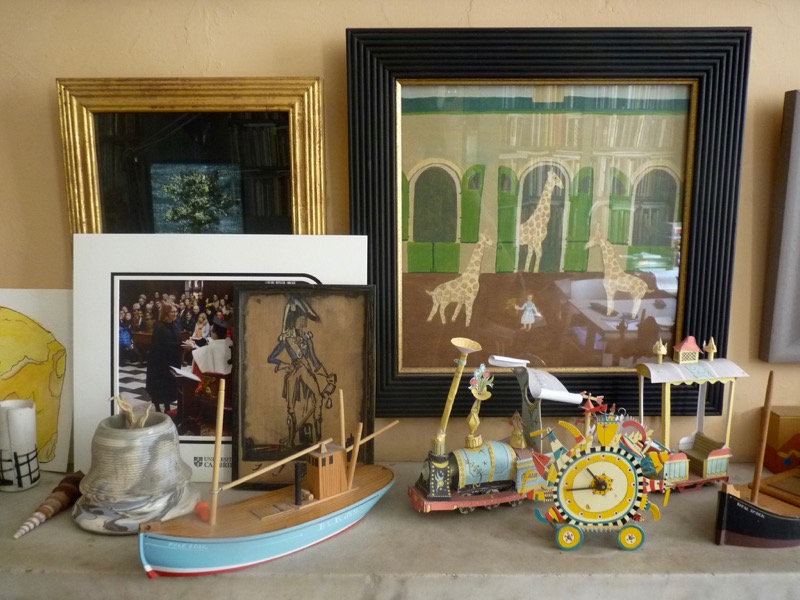

Oh, Ruth, what a delightful home! Love all the paintings and ceramics and Kilburn, the dog! Thank you so much, yet again, for your wonderful photos and how lovely it is to see a house (yet again) that hasn’t been tidied or arranged for the camera. I like a house that looks as if people live there and it’s not just a set piece for a furnishing shop window. I love all the gentle colours, even the pink and yellow candles, the cushions, the rugs, even the quality of light pouring into these rooms. Thank you so much for such a lovely read.
Margaret Powling
http://www.margaretpowling.com
Thank you! Now, hasn’t anyone decided who did design those mugs yet?
Alan Powers has. It’s Kate Irvine. the link is now under the picture.
I wanted to leave a comment re: Romi Behrens, who was a genius. Thank you, had I not clicked onto your blog, I’d have never known about her. Your blog is genius, too. Everything/everyone you have covered is wonderful. Thanks, and I look forward to coming back here.